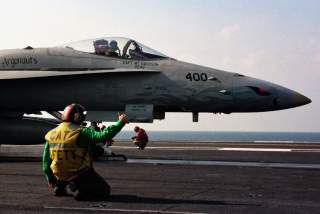Welp: It Looks Like America's F-18 Pilots Aren't Trained Enough for War
Big trouble.
Key point: If America wants to maintain its deterrence, it needs good war games and training. That means revamping how it readies its F-18 pilots.
The U.S. Navy’s fighter pilots lack the skills to defeat Chinese and Russian pilots in combat, one officer warned.
To better prepare for high-tech combat, the sailing branch’s F/A-18 crews should fire more live missiles in exercises and better focus their training, Navy officer Graham Scarbro advised at War on the Rocks.
“Current Navy strike-fighter squadrons do not fire enough air-to-air missiles, and their training mission profiles are too fragmented between air-to-air, air-to-ground and other mission areas,” Scarbro wrote. “In a future conflict with China or Russia, as in the past, naval aviators should expect these deficiencies to yield combat losses unless they are mitigated in peacetime.”
“Firing an air-to-air missile in training is a rare event,” Scarbro explained. “It requires weeks or months of planning, occasional squadron detachments to other airfields and the right combination of training range availability, support assets, logistics and more. Many aviators go their entire career without firing a missile. Those who do typically get just one opportunity.”
The Navy’s training requirements for the F/A-18 Super Hornet dictate that each 12-plane fleet squadron shoot a total of four missiles -- two AIM-9 infrared-guided missiles and two AIM-120 radar-guided missile -- before a deployment.
By contrast the Ault Report, a watershed Vietnam War-era study of air-to-air warfare, recommended the Navy give each pilot with two missiles to shoot during early training plus another two per year thereafter.
“Current FA-18 student aviators fire no air-to-air missiles during their training, perhaps due to the expense and complexity of doing so,” Scarbro pointed out. “Fleet squadrons are only assured of shooting the mandated four missiles per two-year cycle.”
Simulated missile-firings just can’t replace the real thing and still produce a fully-trained aviator, Scarbro wrote. “The first time a live missile leaves your aircraft is a unique experience. Like the first time driving alone with your driver’s license, there are numerous items to check and recheck, procedures to follow and a feel to the experience that no simulation can replicate.”
Defenders of current missile allowances will say that expensive, complicated missiles cannot be “wasted” on peacetime firings while software and simulations are readily available. The problem is that simulations cannot replicate the psychological and physiological effects on a pilot when firing a real missile at a real target. Although simulation capabilities and aircraft integration have improved exponentially since 1968, there is no substitute for the real thing.
Concerns about expense are not unreasonable. The inflation-adjusted per-unit cost of a Vietnam era AIM-7E missile is approximately $165,000, while an AIM-9D is estimated at $81,000. Capt. [Frank] Ault’s plan to give every pilot in every squadron four missiles a year, plus the [training] allocations (approximately 535 pilots in 33 fighter squadrons in 1969) would cost $197.1 million annually in 2019 dollars.
Today’s missiles, the AIM-120C and the AIM-9X Block II, each cost approximately $500,000 and $250,000, respectively. A program of two of these weapons each, per pilot per year, would cost $825 million in missiles alone, assuming that in 1968 each of the 19 fleet F-4 squadrons had 17 pilots, that each of the 11 F-8 squadrons had 15 pilots and that 20 students trained per year in each of the three fighter training squadrons.
Fortunately, the lasting impacts of Ault’s other recommendations mean that the number of missiles once required in 1969 can be pared down today. Technological improvements in aircraft and simulators permit practicing the mechanics of missile firing much more easily than in 1969. Tying missile allocation to a squadron’s workup cycle reduces the number of pilots who need to shoot annually.
Issuing one AIM-120C and one AIM-9X to each deploying pilot during the two-year workup cycle brings the costs closer to Capt. Ault’s program. If four air wings, each comprised of four FA-18 squadrons, deploy annually, two missiles per deploying pilot would cost $192 million annually, assuming approximately 550 fleet pilots for all FA-18 squadrons, with 255 pilots deploying annually.
At the same time, the Navy should consider assigning F/A-18 crews or squadrons to single missions rather than expecting all crews and squadrons to be equally proficient in all tasks, Scarbro recommended.
“Naval aviators should specialize in either air-to-air or air-to-ground missions. The temptation to do both should be avoided, as it will lead pilots to becoming a jack of all trades, masters of none. … Creating two Super Hornet training matrices, one with an air-to-air focus and one tilted towards air-to-ground, would allow the Navy to develop more focused aviators.”
“The Navy could direct each FA-18 squadron to assume a particular role, but a more interesting experiment would be to allow carrier air wing commanders to allocate the matrices for their FA-18 squadrons,” Scarbro wrote. “In this way, an air-wing commander could tailor the wing according to operational priorities.”
David Axe serves as Defense Editor of the National Interest. He is the author of the graphic novels War Fix, War Is Boring and Machete Squad. This first appeared in November 2019 and is being reposted due to reader interest.
Image: Reuters.

